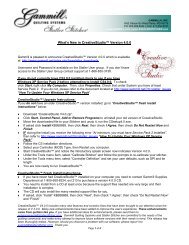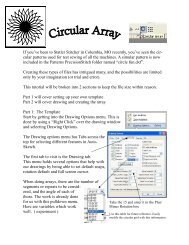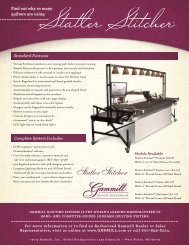Create successful ePaper yourself
Turn your PDF publications into a flip-book with our unique Google optimized e-Paper software.
Quilting the Quilt - Which CS Feature To use<br />
Phase 4 - Backgrounds<br />
E2E Alternating Patterns<br />
Tip: Shifting the patterns up a little is not a problem but when the<br />
pattern needs to be moved up a lot, it might change the number of<br />
rows that can be quilted in the first section. To avoid this, start a<br />
new E2E quilt group and define the Upper Left and Upper Right<br />
corners as being above the upper edge of the quilt. Increase the quilt<br />
length to accommodate this space.<br />
Before quilting, be sure to define another Trim-Inside 133 boundary at the top of the<br />
quilt.<br />
When it looks good, Save the project 60 .<br />
5. Click Quilt The machine moves to the start of the first pattern, takes a<br />
single stitch and prompts you to pull up the bobbin, so do that. Press OK on the<br />
keypad when ready. The first row now begins.<br />
Repeat the steps listed in the previous section to complete the quilt. Be sure to trim<br />
the bottom edge to fit.<br />
Quick Reference E2E<br />
4.4.4 E2E Concatonating Patterns<br />
Edge To Edge patterns can be concatonated giving a very custom look. These<br />
patterns must have been designed with identical structures - the same start point,<br />
end point, size, proportion and nesting shape - for them to work together.<br />
Feature: Edge to Edge - Concatonating<br />
Assumptions: The machine is threaded, bobbins wound, the belts engaged, and<br />
you have patterns that are designed to work together. The Prep Steps here are a<br />
little different than a standard E2E, but the stitching steps will be the same.<br />
Prep Step #1.) Measure the quilt length and width accurately before loading the quilt.<br />
If you are leaving a margin at the top and bottom, be sure to reduce your total quilt<br />
length by this amount. Also it is a good idea to reduce the length a little to<br />
accommodate shrinkage caused by the quilting. This could be from 1% to 5%,<br />
depending on the fabrics, batting and quilting density.<br />
Prep Step #2) Load the quilt and baste the outer edges.<br />
Steps to follow:<br />
180<br />
1. Add the patterns. Using the Add Pattern icon,<br />
find and select the patterns, adding them to the project. If any pattern needs to<br />
appear more than once in the quilting sequence, it needs to be selected more than<br />
Copyright © 2009 <strong>Gammill</strong>, Inc. | All Rights Reserved<br />
147





